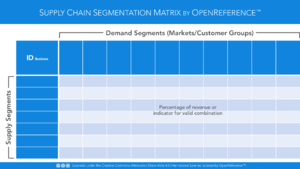Actions
Note: Common inputs and outputs are listed in alphabetical order. Other inputs and outputs may be required to support varying use cases.Segment Supply Chains Align Strategy 4110300 3 Supply Chain, Segmentation, Demand, Supply, Product, Market, Customer, Capabilities, Strategy, Align Dividing a business into subsets ('supply chains') of product/market combinations that have common needs. Supply chain segmentation is dependent upon product segmentation and market segmentation strategies and typically involves understanding product and market characteristics
A103
Difference between revisions of "A103"
m (Text replacement - "t:B2B|Business-to-Business]]" to "t:B2B]]") |
|||
| Line 23: | Line 23: | ||
|name=Segment Supply Chains | |name=Segment Supply Chains | ||
|parent=sc:A1 | |parent=sc:A1 | ||
| − | |sort= | + | |sort=4110300 |
|level=3 | |level=3 | ||
|keywords=Supply Chain, Segmentation, Demand, Supply, Product, Market, Customer, Capabilities, Strategy, Align | |keywords=Supply Chain, Segmentation, Demand, Supply, Product, Market, Customer, Capabilities, Strategy, Align | ||
|description=Dividing a business into subsets ('supply chains') of product/market combinations that have common needs. Supply chain segmentation is dependent upon product segmentation and market segmentation strategies and typically involves understanding product and market characteristics | |description=Dividing a business into subsets ('supply chains') of product/market combinations that have common needs. Supply chain segmentation is dependent upon product segmentation and market segmentation strategies and typically involves understanding product and market characteristics | ||
}} | }} | ||
Latest revision as of 15:04, 27 October 2021
The activities associated with dividing a business into subsets ('supply chains') of product/market combinations that have common needs. Supply chain segmentation is dependent upon product segmentation and market segmentation strategies and typically involves understanding product and market characteristics.
Contents
Use Cases
Supply Chain Segmentation Matrix. A tool for grouping, visualizing, structuring the analysis of a business and determining the supply chains required to meet customer expectations and strategic objectives. The matrix links the supply and demand:- Demand
- Market
- Geography
- Customer types -- Business-to-Business, Business-to-Customer, Business-to-Employee, Business-to-Government, Consumer-to-Consumer
- Customer needs -- Speed, Cost, Reliability
- Customer requirements -- Mode of transport, VMI, Express Delivery, Customized Delivery
- Supply
- Product, product families or product lines
- Geography
- Type (Discrete/Process)
- Make/Buy
- Process capabilities -- Make-to-Stock, Make-to-Order, Engineer-to-Order, Reverse Logistics
- Technology
Alternative methods include the Two-by-Two matrix. Supply Chain Outline
Term(s)
| ID | Name | Clear | x |
|---|---|---|---|
| B2B | Business-to-Business | B2B | |
| B2C | Business-to-Customer | B2C | |
| B2E | Business-to-Employee | B2E | |
| B2G | Business-to-Government | B2G | |
| C2C | Consumer-to-Consumer | C2C | |
| ETO | Engineer-to-Order | ETO | |
| MTO | Make-to-Order | MTO | |
| MTS | Make-to-Stock | MTS | |
| RL | Reverse Logistics | RL | |
| SCO | Supply Chain Outline | SCO |
